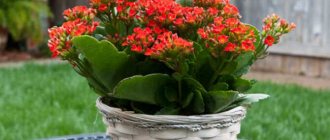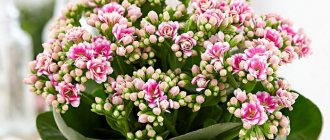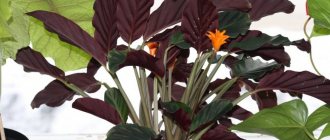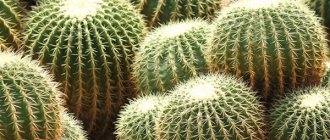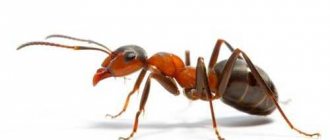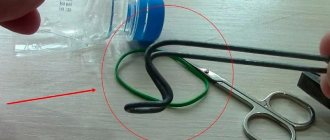The first botanical description of the plant was obtained at the beginning of the 20th century.
The plant is formed by a thick, straight, bare stem bearing traces (convex scars) from fallen lower leaves. Under natural conditions it reaches a height of 3 m; a succulent growing in a pot stretches up to 1.5 m.
The leaves are triangular, elongated, curved into an arc, light olive or light green in color. The leaf blade is covered with short soft brown hair, the edges are raised, highly corrugated.
A paniculate inflorescence, consisting of very small, pale, yellowish or reddish-orange flowers, is formed at the top of the succulent. The flowering of Kalanchoe becharis has no decorative value.
Kalanchoe becharis at The Huntington Californian Garden
Features of the plant
Succulents have many varieties and hybrid species. So you may come across both a woody plant and an ampel plant in the store. But the green friend will always have thick and juicy leaves of a pleasant green color. But their shape can be round, triangular, wavy, with small teeth and even even. There are species with edges, a waxy coating or speckled.
Botanical description
Kalanchoe (lat. Kalanchoe) - depending on the species, they can be herbaceous perennials, subshrubs or succulent plants. In total, more than 200 species of Kalanchoe are known, and the genus itself is part of the Tolstyankov family. Natural habitat - tropical zones of Australia, Asia and America. The leaves of different species differ from each other. Usually thick, may be strongly or weakly dissected, may be sessile, or may have a petiole. Red, white, yellow or purple flowers are collected in umbrella-shaped inflorescences. Almost all types of Kalanchoe tolerate growing indoors well. The main thing is to follow the recommendations for caring for Kalanchoe at home.
Home care
Kalanchoe will not require much effort from you to grow. It can go without water for a long time and does not require maintaining a certain temperature or humidity. In addition, it is a medicinal plant. So it will help in treatment at any time.
Location and lighting
Succulents need a lot of sun. It is only advisable to catch the morning and evening sun rays, and during the daytime either remove them from the windowsill altogether or shade them. You can place a flowerpot with a flower on the east or west window. In winter you can safely place it on a south-facing window sill. If you want Kalanchoe to bloom in the cold season, you will have to supplement it with light.
Temperature
The most favorable environment for a fleshy sprout is +17-19°C. But the flower can withstand a lot of coolness. The main thing is that the thermometer reading does not fall below +5-6 degrees.
It is desirable that the daytime temperature differs from the night temperature by several degrees. This is necessary for the formation of buds and better flowering.
But it is advisable to protect your pet from the heat. If the room is more than 20 degrees, the Kalanchoe will begin to absorb more liquid, and this can lead to rotting of the roots.
Watering
You should remember the main rule - it is better to underfill than to overfill Kalanchoe. The fleshy stems accumulate moisture, so the plant can survive without water for some time. And excess liquid can lead to the death of your green friend.
In summer, water when the substrate is one third dry, and in winter by 2/3, that is, almost completely. The water should be settled and cool. Pour in enough liquid to make the soil moist but not wet. In case of accidental overflow, be sure to drain the excess from the pan.
You need to water so that moisture does not fall on the leaves.
Air humidity
Kalanchoe, which does not like water, also reacts unfavorably to high humidity. The air in the room must be dry, otherwise it will rot and die. Only occasionally should you wash off the dust from the leaves.
The soil
For Kalanchoe, a purchased substrate for cacti or succulents is suitable. You can take universal soil, enriching it with expanded clay or perlite. You can collect the soil mixture yourself. You will need to take:
- 30% turf;
- 30% leaf soil;
- 30% river sand (coarse);
- 10% vermiculite.
Feeding and fertilizers
Kalanchoe does not need frequent feeding. It is enough to apply mineral fertilizer for succulents once a month. During flowering, you can fertilize it once a week, but in small portions. In winter, fertilizing should be stopped altogether. Make sure that there is some nitrogen in the composition, otherwise the bush may rot.
Transfer
A pot for Kalanchoe needs to be deep and wide, since the root system is not inferior in growth to the above-ground part. It is best to take a clay pot. The bottom of the container should be lined a quarter of the height with expanded clay or clay shards for better drainage. The diameter of the flowerpot should be 2-3 cm larger than the previous one.
The bush will have to be replanted every year in the spring, immediately after flowering. After removing the plant from an old pot with a small amount of soil, inspect the roots and get rid of any dried or rotten parts. Move to a new place of residence. In this case, the substrate must be identical to the old one. Place the bush so that the root collar is at the level of the soil mixture. And the upper edge of the flowerpot should protrude 2-3 cm above the soil. Add as much soil as needed and water the pet. Sprinkle a layer of pebbles on top. Adaptation to changing living conditions should take place within a week.
If you need to urgently replant a Kalanchoe during flowering, use the transshipment method. To do this, water the bush thoroughly, transfer it along with the earthen lump into another pot, and fill the remaining cavities with fresh soil.
Trimming
For the beauty of the bush, regular pruning and pinching is necessary. This should be done every spring or early summer after the plant has flowered. Particularly elongated shoots should be reduced by half or even two-thirds.
Those that are too bare will look unattractive, so it is better to cut them off to the base and root the top to form a new plant.
Review of other popular Kalanchoe species
Let us briefly describe the features of other, no less interesting varieties of succulents, which are of considerable interest among gardeners.
Kalanchoe delagoensis
This species is a fast-growing plant that easily propagates wherever it goes, thanks to the tiny shoots that grow along the edges of the leaves. Because of this, in Western countries it is called the "Mother of Millions" and is often confused with a similar plant, Kalanchoe Degremona or "Mother of Thousands", which has wider and longer leaves.
Kalanchoe tubiflora produces showy, bell-shaped flowers in coral pink or orange. Keep in mind that these succulents will not always form flower buds, and some may not bloom at all. This largely depends on environmental factors beyond our control.
Kalanchoe farinacea
A rather attractive, low-growing, thick-skinned perennial plant with curious spoon-shaped foliage. Native to the Yemeni island of Socotra. The height of the succulent is up to 30 cm.
This species is easily identified by its white or whitish-green stem and leaves. During flowering, the succulent produces a peduncle from a panicle, on which straight, reddish-orange cross-shaped flowers are formed. Kalanchoe mealy is the only plant of this genus whose flowers are open for the longest period of the day.
Kalanchoe manginii
Also known as Bryophyllum manginii. In everyday life, this succulent is called “Chandelier”. A slow-growing plant whose stems can reach up to 40 cm in length.
Young bushes have erect stems with small shiny green leaves. The leaves are round and turn reddish in bright sunlight. The flowers are red-orange to bright red and bloom in spring. This is a heat-loving plant, the minimum temperature for which should be 10 °C.
Kalanchoe Luciae
Other names: Kalanchoe Lucy. This species is a fast-growing succulent that produces round, disc-shaped leaves covered with a gray coating. The edges of the leaf blades take on a reddish tint during the cooler winter months.
The amount of sunlight affects how much red blush the leaves show. The inflorescence is thin, cylindrical in shape, the flowers are yellowish-green. Kalanchoe Lucia is a very spectacular plant, easy to care for and is a desirable succulent in any collection.
Also worth mentioning is the variegated form of this flower - Kalanchoe luciae 'Fantastic' . This is a variegated variety, characterized by a whole collage of bright foliage colors.
The leaves are grey-green with creamy yellow or white spots comprising 30-80% of the leaf blade, and the leaf margin takes on a reddish hue in full sun during the hot summer and cooler winter months.
Kalanchoe thyrsiflora
The name Kalanchoe quatrefoil is often used to refer to both Kalanchoe thyrsiflora and the more common species Kalanchoe luciae. The species Luciae is often erroneously called thyrsiflora.
These two plant species are very similar in appearance and growing requirements. The easiest way to notice the difference is when the mature plants grow on a long stem in late winter.
Lucia typically produces greenish-white flowers with a yellow tint, while Kalanchoe quatrefoil flowers have a very bright scent and a deeper yellow hue. Thirsiflora also has a white chalky film on its wider, shorter leaves.
Kalanchoe prolifera
A giant fast-growing succulent from the island of Madagascar (grows up to 4 meters). Visually it looks like a green trunk surrounded by rings with thick leaves with a burgundy rim, rigidly located in the upper part of the stem. The leaves resemble Kalanchoe houghtonii, but usually lack the graceful shoots at the edges.
In bright sunshine, a pinkish-red hue may appear. A terminal inflorescence of yellow flowers, each protruding from a curious pendulous tetrahedral box-shaped bract. This is a monocarpic species, but sometimes a few living buds remain on the stem, and a new plant appears the next year.
Kalanchoe rotundifolia
South African succulent, a very common plant that grows either in large communities under trees or shrubs. In favorable conditions it grows up to 2 meters in height. The stem is erect, usually single (or with a branch at the base), rarely branching at the top.
The leaf blade is elliptical to round-ovate, usually small, but not very fleshy, rather thin, blue-green in color, less often yellowish-green, usually with a grayish-gray bloom, sometimes pinkish. The flowers are erect, tubular, four-petaled, red or orange.
Kalanchoe scapigera
Representative of Angola (Namibe Province). This is a small perennial succulent plant, 30 cm tall, with thick, almost round leaves and spatulate inflorescences with fleshy bright yellow flowers.
The entire plant is bare, covered with a white powdery coating. This species is often confused with Mealy Kalanchoe.
Kalanchoe synsepala
Another name is “Walking Kalanchoe”. Beautiful perennial plant. A very variable species, it can have a huge variety of shapes and sizes. The most common form has broad gray-green leaves with bright green coloring and pink-purple edges.
The stem is short, woody, rather thick, always branched, up to 40 cm tall. The inflorescences are axillary, usually two opposite very dense corymbose racemes, 2-9 cm long. The flowers are tubular, pale white or pinkish to reddish in color, and quite small.
Kalanchoe marnieriana or Marnier (Kalanchoe marnieriana)
This species was named after the French botany researcher Julien Marnier Lapostolle. This is a unique blue-green succulent. The flower can grow up to 45 cm in height and spread up to one meter. It has flat, thin, blue-green or gray round leaves located opposite each other, which may take on a pinkish tint at the edges.
Kalanchoe Marnier sometimes sends out shoots along the edges of its leaves, which eventually fall off and give rise to new plants. The flowers are hanging, large, coral in color, and bell-shaped. Flowering season is winter.
Kalanchoe laxiflora
Plant up to 30 cm high. Slightly toothed, fleshy leaves of different shades of green with red edges.
Bell-shaped flowers in orange, red or purple hues open at the top of the flower stalks in winter.
Kalanchoe 'Tessa' (Kalanchoe 'Tessa')
Hybrid of Kalanchoe mangin and Kalanchoe gracilipes. The succulent usually grows up to 30 cm in height and approximately 60 cm in diameter.
The leaves are green, oval, fleshy with reddish edges. The flowers are tubular in shape and bloom in late winter until spring. blooming in spring on thin stems.
Kalanchoe sexangularis
A hardy, drought-tolerant, fast-growing succulent with beautiful red foliage. Unlike other succulents, these plants bloom well in light shade. Plants of this species can grow up to 90 cm in height. They have ribbed or square stems.
The leaves are green, elliptical, cupped, with thick, rounded, serrated edges. The edges of the leaves are red, and older leaves often turn pinkish-brown at the edges. The flowers are bright yellow, with a branched inflorescence.
Kalanchoe hildebrandtii
The common name is “Silver Spoons”. It is a succulent shrub that grows up to 90 cm in height. It has woody stems.
The main feature of the plant is its silver-gray leaves, which give the succulent a fantastic look. Flowers in the form of small white bells. Flowering season is spring.
The article uses photos from the resource commons.wikimedia.org and materials from the sites:
- succulentsnetwork.com
- plantcaretoday.com
- wikipedia.org
- kalanchoe-succulent.com
Bloom
From mid-October to early March, when daylight is short, Kalanchoe produces many flowers. To get flowering in the warm season, you will need to “deceive” the plant, imitating darkness. To do this, for six weeks, you should hide the flowerpot with a flower in an unlit place every day and keep it there for 14 hours, and keep it in daylight for only 10 hours. In this case, watering should be reduced by half.
For flowers to form en masse, it must be +7 degrees at night, and no more than 16 degrees during the day. Make sure that the thermometer does not drop to +4 degrees or below. This can be fatal for your pet.
Under such conditions, Kalanchoe will bloom in 5-7 weeks. Once the bush blooms, resume normal care. Dried flowers should be removed. This will stimulate the development of new ones.
If you took a pot of Kalanchoe outside for the summer, then return it back to the apartment without waiting for frost. After 3 months it should lose color.
When you bring a bush from the store, do not immediately place it in the sun. First, shade with a piece of fabric. After a few days, begin to remove the cover little by little, gradually increasing the intervals in the light. Otherwise, the plant may drop its flowers, since the store is usually dim, and watering is done quite often.
News:
Article date: 11/17/2007Family: Crassulaceae.
Homeland: tropics and subtropics of the Earth.
Flowering: depending on the species.
Growth: fast.
Light: bright. The plant can tolerate direct sunlight.
Temperature: In summer - within 18-28°C, in winter - not lower than 10-12°C, best at 16-18°C.
Watering: in the spring-summer period, moderate or abundant, depending on the temperature and lighting. In autumn, watering is reduced; in winter, watering is done carefully.
Air humidity: the plant easily tolerates dry air in apartments.
Feeding: in summer, mineral fertilizers are applied weekly and organic fertilizers are applied once every 2 weeks. In the fall, when planting buds, fertilizing can be repeated.
Pruning: after flowering, the stems of Kalanchoe are trimmed a little so that the plants are neat and have a decorative appearance.
Rest period: mild. In winter, it is recommended to keep the plant at 16-18°C.
Replanting: as needed.
Reproduction: stem and leaf cuttings, pups (those species that have them) and seeds.
The genus Kalanchoe, Kalanchoe (Kalanchoe Adans) has 200 plant species and belongs to the Crassulaceae family. Representatives of the genus are distributed in the tropical regions of Australia, on the islands of New Guinea, the Moluccas, Madagascar, as well as in tropical America (one species), in tropical and subtropical regions of Asia.
Succulents, perennial herbaceous plants or subshrubs. The leaves are thick, more or less pinnately dissected, sessile or with petioles. The flowers are collected in multi-flowered umbrella-shaped inflorescences, yellow, white, purple, bright red. All Kalanchoes are popular ornamental plants. They bloom profusely and for a long time.
All types of Kalanchoe are relatively resistant to indoor conditions.
Kinds:
Kalanchoe bentii CH Wright ex Hook. f. Synonym: K. bristle-leaved (Kalanchoe teretifolia Deflers) . The homeland of the species is the Arabia Peninsula (southern part). Subshrubs are sparsely branched, powerful, up to 1 m tall. The leaves are arranged in 6 pairs, rounded, large, up to 40 cm long, thick. The inflorescence is umbellate. The flowers are white; the corolla tube is swollen at the base, 2.5 cm long; petals are back ovoid, no more than half the length of the tube. Blooms profusely in April-May. Highly decorative plant. Suitable for moderately cool rooms.
Kalanchoe beharensis Drake et Castillo. The homeland of the species is the island of Madagascar (southern part). Shrubs, powerfully developed plants with shoots bare below and tomentose at the top. The leaves are almost entire or slightly serrate, pubescent. The flowers are small, up to 7 mm long, pubescent; the corolla tube is pitcher-shaped; linear shaped petals. Blooms profusely. Highly decorative plant. Suitable for moderately cool rooms. Has a number of varieties.
K. Blossfeld (Kalanchoe blossfeldiana Poelln.) - photo. Synonym: K. sharanosnoe diff. bright red (Kalanchoe globulifera var. coccinea H. Perrier). Grows in tropical rainforests on humus soil on the island of Madagascar. Subshrubs, few branches, erect, up to 30 cm tall. The leaves are ovate, up to 7 cm long and 4 cm wide, glabrous, green, reddish at the edges. The flowers are numerous, collected in umbrella-shaped inflorescences. The flowers are erect, up to 1 cm in diameter and 1.2-1.3 cm long, red; melliferous scales are narrow-linear, bilobed. It blooms profusely and for a long time, in February-May (it can bloom at other times of the year). Most plants are removed after flowering, but they can be preserved until the next season - cut off the flower stalks, place the pot on a shady windowsill, hardly water it for a month, and then move it to a well-lit place and care for it as usual. From Kalanchoe Blossfeld came the bizarre ampelous varieties and garden forms. They are very decorative - with white, yellow, orange, purple, red and pink flowers. Among them there are low-growing and medium-growing varieties.
K. tomentosa (Kalanchoe tomentosa Baker) . The homeland of the species is the island of Madagascar (central part). This plant is sometimes called "cat ears". Subshrubs. The shoots are erect, covered with dense hairs. The leaves are oblong-ovate, 5-6 cm long and 1.4-1.6 cm wide, entire, less often serrate, sessile. The inflorescence is small, umbrella-shaped. The corolla tube is short, 12 mm long; petals 12 mm long. Blooms profusely. Highly decorative plant. There are a number of varieties.
| K. beharensis | K. blossfeldiana | K. tomentosa |
K. Degremona (Kalanchoe daigremontiana Raym.-Hamet & H. Perrier) . Synonym: Bryophyllum daigremontianum (Raym.-Hamet & H. Perrier) A. Berger. The plant's homeland is the island of Madagascar. Perennial herbaceous plants up to 50 cm tall, with oblong-elliptical fleshy leaves up to 10 cm long, slightly curled along the midrib, gray-green on the upper side and variegated on the lower side, glabrous, serrated along the edge. Violet specks are scattered across the main light green background. The inflorescence is paniculate. Corolla pink; corolla tube up to 1.7 cm long; petals are short, 0.7 cm long. Blooms profusely, usually in winter. A peculiarity of this plant is the ability to form brood buds in the depressions between the teeth along the edge of the leaf, from which children and young individuals equipped with tiny aerial roots are formed directly on the plant. Falling, they quickly take root and move on to independent existence.
K. marbled (mottled) (Kalanchoe marmorata Baker) . Synonyms: K. large-flowered (Kalanchoe grandiflora A. Rich.), K. large-flowered (Kalanchoe macrantha Baker), K. Somali (Kalanchoe somaliensis Baker). It is found in the mountains, at an altitude of 1600-2300 m above sea level, in Ethiopia. Subshrubs 50 cm tall. The leaves are obovate, 8-12 cm long, tapering at the base, notched-toothed at the edges, green, later grayish on both sides, with large brown or lilac spots. Umbrella-shaped inflorescence - photo. The flowers are white; corolla tube 7-8 cm long, 4-sided; petals are ovate-lanceolate. Blooms in January–April. Highly decorative plant. Suitable for moderately cool rooms.
K. grandiflora (Kalanchoe grandiflora A. Rich.) . Synonym: Kalanchoe marmorata Baker. The homeland of the species is India. Subshrubs up to 60 cm tall. The leaves are lobed-toothed, sessile or on short petioles, light green (reddening in the sun). The inflorescence is umbellate. The flowers are light yellow; corolla tube expanded, 1.2 cm long; petals are ovoid, fragrant. Blooms profusely in May. An ornamental plant valued for the pleasant aroma of its flowers. Suitable for moderately cool rooms.
| K. daigremontiana | K. marmorata | K. grandiflora |
K. Mangina (K. manginii Raym.-Hamet & H. Perrier) . Synonym: Bryophyllum manginii (Raym.-Hamet & H. Perrier) Nothdurft. The plant has fleshy leaves like Kalanchoe Blossfeld, but the drooping pink bell-shaped flowers are larger. Very beautiful ampelous look. This plant and its many hybrid varieties usually bloom in spring.
K. paniculata (K. thyrsiflora Harv.). Lives on rocky slopes in South Africa. Perennial herbaceous plants up to 60 cm tall, densely leafy. Leaves are obovate, up to 15 cm long and 7 cm wide, obtusely rounded, silvery-white; lower ones in a rosette, densely located; the upper ones are located less frequently, smaller than the lower ones. The inflorescence is a panicle. The flowers are yellow; the corolla tube is pitcher-shaped, swollen, 4-sided, 1.5 cm long; petals are small, round, up to 0.5 cm long - photo. Blooms profusely in April-May. Highly decorative plant. After flowering, the plants form many bulbous buds, which are widely used for plant propagation.
K. fiery, or fiery red (K. flammea Stapf) . Synonym: K. bluish (Kalanchoe glaucescens Britten . Grows on rocky soil in Somalia. Perennial herbaceous plants 30-40 cm tall, poorly branched. Leaves obovate, 6-8 cm long and 2.5-3 cm wide, tapering at the base, bluntly rounded, serrate. The inflorescence is umbellate. The flowers are bright orange-red; the corolla tube is widened; the petals are triangular-ovate, up to 2 cm in diameter - photo. A highly decorative species for potted culture, suitable for moderately cool rooms.
K. pinnata (Lam.) Pers. (K. pinnatum (Lam.) S. Kurz.). Synonyms: Crassula pinnata L. f., Cotyledon pinnata Lam., Bryophyllum pinnate (Bryophyllum pinnatum (Lam.) Oken) . Grows on rocky soils at an altitude of 1000 m above sea level on the island of Madagascar. Perennial herbaceous plants up to 1 m tall. The leaves are fleshy, the lower ones are simple, ovate, often with a heart-shaped base, light green , rounded-toothed at the edges - serrated and red; upper (young) pinnate, with 3-5 leaflets; upper unpaired leaflet 8-12 cm long and 5-10 cm wide. Flowers drooping; corolla tube up to 3.5 cm long, greenish -white; triangular, brick-red petals; reddish-green calyx. Blooms profusely, but not regularly. In the recesses between the teeth, like Kalanchoe Degremona, brood buds are also formed (most often on leaves that have fallen from the plant and lie with the underside on the soil ), from which tiny young plants with aerial roots develop, gradually taking root in the soil.
| K. manginii | K. thyrsiflora | K. pinnata |
K. tubiflora, or tubiflora (K. tubiflora (Harv.) Raym.-Hamet). It lives on rocky sandy soils on the island of Madagascar. Perennial herbaceous plants, subshrubs up to 70 cm tall. The leaves are numerous, narrow and long, up to 13 cm long and 0.6 cm wide, grayish-green, with dark brown spots, in the upper part with many brood buds. The flowers are numerous, red; corolla tube 2.5 cm long. Highly decorative plant. Blooms profusely. Tolerates indoor conditions well. It is widely used in cultivation as a potted plant and is used to decorate bowls. There are many varieties. The varieties differ in plant height: low-growing - 10-15 cm, medium-growing - 15-20 and tall - 25-30 cm in height. There is significant diversity in the color of the flowers: scarlet red, dark purple, bright pink, fiery red, light yellow, orange, light purple, white.
| K. tubiflora | K. tubiflora |
K. dissected or lobed (Kalanchoe laciniata DC.) . On the Internet it is referred to as K. jagged, the popular name is “Olenki horns”. Grows in Africa, subtropical and tropical Asia. A perennial herbaceous plant with succulent fleshy shoots, first erect, then lodging; the lower part of the plant becomes bare over time. The leaves are fleshy, deeply dissected, serrated at the edges, light green with a waxy coating. The flowers are tubular yellow-orange. Blooms profusely. The soil is suitable soddy-sandy. In the autumn-winter period, watering is limited, after complete drying of the earthen coma, good lighting. Periodic pruning of shoots. Thanks to the shoots that droop over time, it can be grown as an ampelous plant.
K. lobata is used in India in folk medicine.
| Kalanchoe laciniata | K. lacinata | K. laciniata (flowers) |
Plant care:
Flowering Kalanchoe is a short-day plant. From spring to autumn, it is better to keep it on the windowsill of an eastern or western window; in winter, southern exposure is preferable for the plant. During the flowering period, Kalanchoe requires bright lighting. In the autumn and winter months, when the duration and intensity of natural light decreases significantly, plants need to be additionally illuminated in the evening and in the morning, bringing the daylight hours to 12 hours. In August, illumination time should not exceed 9 hours. Do not forget that a purchased plant, either a plant after long cloudy weather or standing in partial shade, is gradually accustomed to bright light in order to avoid sunburn.
Almost all types of Kalanchoe can be grown in a wide range of temperatures. In summer - within 18-28°C, in winter - not lower than 10-12°C, best - at 16-18°C. At high temperatures in autumn and winter, flower buds do not form.
In spring and summer, Kalanchoe is watered moderately; if the plant is kept in the sun, then it is watered abundantly, as the top layer of the substrate dries, in winter - much less often, with soft, settled water, but do not stop watering completely, since when the plants dry out, they lose a lot of leaves. Water can be poured not from above, but into the pan.
Thanks to fleshy leaves covered with a waxy coating or numerous hairs, all Kalanchoe plants tolerate the arid air of city apartments well. Air humidity does not play a significant role for the plant. Kalanchoe does not require spraying, but on a hot summer day this can only benefit the plant.
In summer, mineral fertilizers are applied weekly and organic fertilizers are applied once every 2 weeks. In the fall, when planting buds, fertilizing can be repeated. You can feed it with cactus fertilizer.
Plants are formed by pruning long shoots. In some forms, the stems, having reached a certain height, begin to bend over the edge of the bowl or pot. 6-8 cuttings planted along the edges of the pot take root, bend and hang down as they grow. Such plants with shiny leaves and rich inflorescences acquire a very decorative appearance. Plants in containers with holes through which the stems hang are original. In this form, even non-flowering ampelous Kalanchoe plants are very attractive.
In order for Kalanchoe to bloom earlier, in spring and summer it should reduce daylight hours to 12, or even 10 hours. But in order for the flowers to be large and bright, the lighting must be intense. Some species have flowers of delicate and bright shades, very beautiful, and stand cut in water for a long time (about three weeks) without fading. After flowering, the stems of Kalanchoe are trimmed a little so that the plants are neat and have a decorative appearance. Cut off parts of the plant are used for cuttings.
Transplantation is carried out as necessary (overgrown plants). The soil for transplantation is neutral or slightly acidic (pH 5.5-6.5). Plants grow well in the usual mixture for succulents, with the exception of epiphytic species, for which it is advisable to add humus soil and use fertilizing fertilizers for abundant flowering. Young plants are transplanted into a mixture of 4 parts turf, 2 parts deciduous soil, 1 part rotted peat and sand. Instead of peat, you can use coniferous soil. You can add some horn shavings and dry cow dung to the mixture. The bottom of the pot provides good drainage. Kalanchoe grows well in hydroponic culture.
Kalanchoe is propagated by stem and leaf cuttings, cuttings (those species that have them) and seeds.
Typically, old leaves that fall can be rooted to produce young plants. If you plant a leaf in wet sand in June and cover it with a glass, it will soon form roots. Brood buds (babies) of viviparous species are planted in fertile soil substrate mixed with sand.
The seeds are sown in January - March; they are not covered with soil, but only pressed down, covered with glass and shaded with paper. The soil for sowing is light and leafy. The room temperature should be 16-18°C. The crops are ventilated daily 2 times a day, turning the glass over to the other side. It is necessary to ensure that the soil on the crops does not dry out. Water at room temperature. When shoots appear, the glass and paper are removed. A month later, the seedlings are planted in a box and covered with glass or plastic wrap for a couple of days. When the plants grow several leaves, they are transplanted into 7-centimeter pots. The nutrient mixture is made up of 4 parts deciduous, 2 parts turf soil, 1 part compost and 1 part sand or 4 parts peat, 2 parts turf soil and 1 part sand. In young rooted plants, pinch off the top. In July, the plants are pinched again to form a bush, which usually develops 4-5 shoots. Transshipment is done in August, when the plants have developed well and the roots have entwined the earthen ball. 1-2 plants are planted in pots. When transshipping, the earth mixture is made up of 4 parts compost, 2 parts humus and 1 part each of deciduous soil and sand, adding a little dry cow manure. Plants bloom a year after sowing.
Healing properties:
Residents of Madagascar have long used the juice of many types of Kalanchoe to treat various diseases. In everyday life, Kalanchoe is often called “indoor ginseng” or “tree of life”. Cellular juice isolated from the stems of fresh leaves of Kalanchoe pinnate has an anti-inflammatory effect, does not irritate the skin and mucous membranes and is successfully used to stimulate tissue regeneration processes, for example in dentistry, in gynecology (during childbirth, for the treatment of ruptures, for the treatment of cervical erosion). For cracked nipples in nursing mothers, it is used 2-3 drops after feeding for 5-6 days. Kalanchoe juice is used for healing wounds, trophic ulcers, bedsores, burns, frostbite, as well as for tonsillitis, periodontal disease and stomatitis. Kalanchoe is recommended for migraines, suffocating cough, stomach and liver diseases, some infectious diseases and influenza, for the treatment of acne, boils, warts. With the help of a crushed Kalanchoe leaf you can get rid of toothache. Kalanchoe juice is sold in pharmacies, but it must be remembered that it should not be consumed without a doctor’s recommendation.
Possible difficulties:
With excess heat and moisture, powdery mildew may appear.
If placed too damp or cold, it becomes susceptible to gray mold.
A number of species grow quickly, this is a natural process for the plant.
Author of the article: Marina Mityaeva
Discuss the article and care on the forum
Kalanchoe - problems, their solutions
We propagate Kalanchoe
Identifying our Kalanchoes is a topic by definition.
Kalanchoe - photos and reviews we admire together!
Share the link
Materials used in the article:
Saakov S.G. Greenhouse and indoor plants and their care. - L.: Nauka, 1985. - 621 p.
Indoor floriculture / R. Milevskaya, Y. Vies. - Mn.: Book House, 2005. - 608 p., ill.
Stepura A.V. Home decorative floriculture. Modern encyclopedia: 5000 valuable advice from professionals. - Donetsk: LLC PKF "BAO", 2006. - 384 p.
Cacti and other succulents: Directory / D. Beffa; Per. from Italian I.V. Artyushina; Ph. K. Dani. - M.: LLC - "AST Publishing House": LLC "Astrel Publishing House", 2003. -335, [1] p.: ill.
https://www.plantoftheweek.org/week375.shtml
https://spazioinwind.libero.it/piantegrasse/schede_succulente/kalanchoe_beharensis.htm
https://foroantiguo.infojardin.com/showthread.php?t=145630
https://www.plantoftheweek.org/week340.shtml
https://blogs.sun.com/richb/resource/richb_blog.html
https://www.killerplants.com/plant-of-the-week/20030324.asp
https://commons.wikimedia.org/wiki/Image:Kalanchoe_marmorata.jpg
https://www.golatofski.de/Pflanzenreich/gattung/k/kalanchoe.htm
https://davarree.free.fr/kalanchoe_grandiflora.htm
https://www.cambridge2000.com/gallery/html/P4114564e.html
https://www.cactus-succulents.com/Succulents.htm
https://www.smgrowers.com/info/kalanchoeluciae.asp
https://www.desert-tropicals.com/Plants/Crassulaceae/Kalanchoe_flammea.html
https://www.lapshin.org/succulent/album/Kalanchoe-pinnata-1030-1a-2003.jpg
https://davarree.free.fr/kalanchoe_tubiflora.htm
https://madagaskar.malala-madagascar.net/htm_bilder_madagaskar_einfach_schoen.htm
https://www.toptropicals.ru/cgi-bin/garden_catalog/cat.cgi?uid=Kalanchoe_laciniata
Reproduction
You can get new Kalanchoe plants in different ways:
- cuttings;
- leaves;
- seeds;
- children;
- kidneys;
- offspring.
You should choose a propagation method depending on the type of flower you grow.
Cuttings
You need to choose long shoots of at least 8-12 cm. Cuttings from apical shoots take root best. Rooting can be done in two ways:
- Cut off the cuttings and let them sit for 24 hours to dry. Remove the lower leaves. Moisten the soil in the pot and plant the cuttings in it. After 2-3 weeks it should take root.
- Prepare the cutting as described above. Then lower it into water so that half of the stem is in the liquid. The glass of water should not be in direct sunlight. When the roots appear after 2-3 weeks, you can transplant the sprout to a permanent place.
Leaves
Even a novice gardener can perform this procedure with consistent success. Cut the leaf and plant it in a well-moistened substrate. Cover the top with a glass jar. The roots should emerge within 3-4 days. After this, the plant will quickly grow.
For this purpose, you can even use fallen leaves if they have not dried out. You just need to root them in a glass of water. And after the roots appear, replant.
Seeds
This method should be used in the cool season. Sprinkle the seeds on top of the substrate without digging into the ground, just press lightly. Pour a trickle of water over the top to create a depression. Cover the top with a piece of cloth or glass. Avoid exposure to sunlight.
When the shoots appear, plant them in a box, covering the top with polyethylene. And only when 4-5 leaves are formed on the sprouts, plant them in small separate flowerpots. After a month, pinch off the tops. And then repeat this procedure after another 30 days. New plants should bloom in about a year.
Children
This method works best for pinnate Kalanchoes and Degremonas. It is in these species that babies are formed at the edges of the leaf edges, which have roots. Having matured, they fall off and take root in the soil mixture. All you have to do is wait until they have leaves and plant them in a container for rooting. When they gain strength, transplant them into separate flowerpots.
Axillary buds
Axillary buds appear in some species of Kalanchoe at the very hilum when the old leaf falls off. In appearance they look like small heads of cabbage. When it reaches 1-2 cm in height, trim it carefully and plant it in sandy soil. This will make it easier for the shoot to grow.
Offspring
After the Kalanchoe has finished flowering, pinch the apical shoot. Wait until new offspring appear next to the mother shoot. When they reach a third of the height of the mother bush, plant them in the substrate. Such sprouts take root well and grow quickly.
Species of the genus Kalanchoe with showy flowers
Almost all Kalanchoe bloom beautiful flowers of different shapes, sizes and colors. But several species of this succulent are highly prized by many gardeners because of their amazing flowers.
Kalanchoe blossfeldiana
This species is named after the German breeder Robert Blossfeld (1882-1945). One of the most common houseplants is a dark green succulent perennial shrub with fleshy leaves and large clusters of flowers located above the foliage.
It has erect, branched stems. The flowering time of Kalanchoe Blossfeld is incredibly long for a houseplant - from the second half of autumn to the beginning of spring.
There are varieties with bright red, pink or yellow flower colors. The most famous series of Blossfeld varieties is the double Kalanchoe Kalandiva . This varietal series was originally bred in the Netherlands.
A special feature of Kalandiva is its unique double flowers, visually similar to the buds of garden roses. Other varieties worth mentioning:
- Kalanchoe 'Tom Thumb' is a miniature shrub form, no more than 15 cm high, with reddish foliage and small dark red flowers;
- Kalanchoe Blossfeldiana 'Vulcan' is a long-flowering succulent with large scarlet flowers, growing up to 20cm, flowering 20 weeks after sowing;
- Kalanchoe Blossfeldiana 'Compacta Lilliput' is another diminutive form of the plant with red flowers, growing no more than 15 cm;
- Kalanchoe Blossfeldiana 'Orange Triumph' is a rare variety with orange flowers;
- Kalanchoe Blossfeldiana 'Goldrand' is a less common form of succulent with yellow flowers.
Kalanchoe Fedtschenko
Formerly known as Bryophyllum fedtschenkoi, this species is named after the Russian botanist Boris Fedchenko. This is a low-growing, frost-resistant perennial succulent that grows up to 30 cm in height. The stems are round, smooth, with noticeable scars on the leaves, often bending and touching the ground.
The leaves are fleshy, alternate, blue-green, oval or obovate with fine serrated edges. The leaf tips may turn pink or red in bright sunlight or dry conditions. In late spring - early summer, the plant produces flower stalks with clusters of small bell-shaped flowers. Reddish-brown flowers hang loosely from upright stems.
Houghton's Kalanchoe (Kalanchoe Houghtonii)
The hybrid of Kalanchoe daigremontiana and Kalanchoe delagoensis can be recognized by the V-shaped leaves. It is a biennial, erect, unbranched plant, about 75 cm tall. The leaves are boat-shaped, fleshy, triangular, emerald green to brownish green in color, usually with purple spots below and jagged edges.
Sprouts grow en masse along the edges of the leaves. Spectacular flowers are hanging, bell-shaped, collected in clusters, orange-pink in color. This plant is virtually indestructible and requires no care... none at all. Even if you throw it into a pile of garbage, it will continue to grow and bloom for a long time.
Diseases and pests
Like any other indoor plants, Kalanchoe can be attacked by parasites.
- Aphid. You can get rid of small dark green insects by treating the bush with potassium soap. Too severely affected areas will have to be removed.
- Shield. Gray plaque should first be treated with an alcohol solution, then brush off the insects. Then repeat the alcohol treatment.
- Rot. If you find brown spots, stop watering for a while and partially replace the earthen ball. Then start watering with fungicides.
- Powdery mildew. White plaque appears due to too high air temperature. You will have to spray the bush with a fungicide solution.
- Gray rot. If you find weeping gray spots, you should partially replace the soil, treat the plant with a fungicide and move it closer to the light.
Briefly about cultivation
- Flowering: within a month from the end of winter.
- Lighting: daylight under bright diffused light should last 12 hours.
- Temperature: in summer – from 18 to 28 ºC, in winter – from 14 to 18 ºC. Lowering the temperature to 10 ºC or lower is unacceptable.
- Watering: through a tray: during the growing season - moderate, as soon as the top layer of the substrate dries, in winter the substrate should dry by a third between waterings.
- Air humidity: normal for residential premises, but in hot weather spraying with warm water is recommended.
- Feeding: in summer and autumn (during budding) - weekly fertilizer for cacti and succulents. Organic fertilizers can be applied no more than twice a month.
- Pruning: After flowering, you need to trim off all flower stalks.
- Dormant period: within 1-1.5 months after flowering.
- Transplantation: at the beginning of active growth, after the roots of the plant fill the pot.
- Substrate: four parts turf soil, two parts leaf and one part each peat and sand. A ready-made substrate for succulents and cacti is also suitable.
- Reproduction: seeds and cuttings.
- Pests: mealybugs, scale insects, spider mites, aphids.
- Diseases: powdery mildew, late blight, gray rot, stem rot, leaf ring spot.
- Properties: Kalanchoe is a medicinal plant with anti-inflammatory, antibacterial, wound-healing, hemostatic and bactericidal effects.
Read more about growing Kalanchoe below.
Care errors
If you care for Kalanchoe incorrectly, certain problems may arise:
- The bush doesn't bloom. This may be a consequence of too much fertilizer or too much daylight.
- The leaves curl. The cause may be thrips or leaf rollers. The bush needs to be treated with insecticides or miticide.
- Brown spots on leaves. Appear from excess ultraviolet radiation. Reduce daylight hours for your pet.
- Black spots on leaf blades. They provoke fungal diseases. The temperature in the room should be increased and the humidity reduced.
- Leaves are falling. Move the flowerpot away from the radiator or other heating source.
- The leaves turn yellow and dry out. Due to improper lighting.
- Withering of a flower after flowering. Urgent feeding or replanting is required.
Popular Kalanchoe species with amazing leaves
In this group we have collected succulents, which are primarily valued for the wonderful color of their leaves. Few natural plant species of other genera can boast of their spectacular spotted or multi-colored leaves.
Kalanchoe humilis
A spectacular low-growing perennial succulent with very decorative leaves with pronounced burgundy stripes. Forms a small shrub 30-90 cm high. The stem is relatively short - up to 10 cm long, growing from a woody base up to 1 cm thick, unbranched or with several branches, purple or slightly gray.
Leaves are up to 13 cm and 6 cm wide, completely glabrous, gray-green with a slight grayish-brown coating on both sides. Pronounced burgundy spots and stripes on the leaves are a distinctive feature of this species. As the plant ages, the leaves at the bottom of the plant fall off. An erect, branched panicle up to 12-38 cm grows from the center of the rosette and produces abundant flowers from green to pink.
Another popular cultivar of this species is Kalanchoe humilis cv. Desert Surprise: A bred clone with blue-green lobe-shaped leaves with striking purple spots.
Marbled Kalanchoe (Kalanchoe marmorata)
Another species with beautiful leaves. Endemic to Central and Western Africa. The succulent forms a small bush 30-40 cm high and wide at home, although it reaches 1.2 m in the wild.
The name of the species was given because of its brightly colored leaves with brownish-purple spots. The erect inflorescences grow up to 10 cm in length and contain delicate, star-white, four-petaled flowers, sometimes tinged with pink.
Kalanchoe mysterious (Kalanchoe orgyalis)
The species is native to the island of Madagascar. A slow growing plant, it forms a rather stately plant when mature, known for its hairy bronze leaves.
Over time, the lower leaves turn silver, creating a beautiful contrast with the newer copper leaves. Because of the shape and color of the leaves, Kalanchoe mysticus is often called copper spoons.
Kalanchoe rhombopilosa or rhombopilosa
This is an elegant small shrub, one of the smallest species of the genus (no more than 20 cm high), with branched silvery stems with brown spots. The leaves are diamond-shaped or fan-shaped with striking copper-brown markings, most covered with a silvery-white coating.
The outer edge of the leaves is beige with sharp teeth. There are several forms with absent or abundant markings. The flowers are inconspicuous, greenish-yellow with red lines.
Kalanchoe figuereidoi
Another name is “Partridge”. Often confused with Kalanchoe humilis. Compact succulent with wide, silver-gray, fleshy, toothed leaves. On their surface there are dark striped spots and pale veins.
Typically blooming in mid-winter, the inflorescence is forked multiple times to hold a cluster of small pale green and pink flowers with scarlet tips. One of the top ten favorites among experienced gardeners.
Folk signs
Kalanchoe is suitable for breeding for energetic and purposeful people. This is the kind of flower that will be conducive to achieving success and conquering new heights.
But for those who suffer from indecision, it would be useful to place a flowerpot with a succulent in their home. This will help you gain confidence in your abilities.
If you have problems in your family life, place a pot of flowers on the windowsill, and your feelings with your spouse will get a second wind. And for unmarried people, the fleshy leaves will help attract a groom.
If you notice that the Kalanchoe has begun to fade, you should know that damage has been caused to you or your home.
Medicinal properties
The juice of the fleshy leaves of Kalanchoe is used for external use both in official medicine and at home. Lotions and compresses made from it can be used in the following cases:
- boils;
- trophic ulcers;
- non-healing wounds;
- cracked nipples;
- sunburn.
For a runny nose, it is recommended to apply drops into the nose of adults and children.
In addition, the plant is able to kill harmful microbes floating in the air. So it wouldn’t hurt to place a pot of succulents in each room.
As you already understand, growing Kalanchoe is not difficult. The flower will not require special care from you. But it will always delight you with its beautiful flowering and beneficial properties.
Varieties of Kalanchoe with pubescent leaves
This conditional group of succulents is united by one feature - their leaves are covered with hairs or fluff, which in turn adds to their decorativeness.
Kalanchoe tomentosa
Easy to grow and quite hardy, this is an upright evergreen succulent with soft, fluffy, fleshy leaves, 9 cm long, reminiscent of cat ears.
This native of Madagascar does not bloom as often as other succulents in the home and is grown primarily for its unusual foliage. In summer, clusters of yellow-green flowers with dark brown petal tips may appear on 45cm stems. Kalanchoe tomentosa grows up to 90 cm in height and 60 cm in width.
Also worth mentioning is the beautiful dwarf variety of Kalanchoe tomentosa - “Chocolate Soldier” (Kalanchoe tomentosa cv. Chocolate Soldier) . This is a beautiful, slow-growing perennial succulent plant with dense white felt-like hairs covering the entire leaf.
A small, upright growing bush reaches approximately 40 cm. This is a very attractive variety, which has many varieties with different color options. It is valued primarily for its fluffy leaves.
Kalanchoe dwarf (Kalanchoe pumila)
This is a bushy succulent with hanging and spreading stems. It grows 20 to 30 cm long and 30 to 60 cm wide. It looks amazing hanging from hanging baskets. This flower has curved stems, densely covered with rounded leaves up to 5 cm long.
The leaves are silver-gray with a pinkish tint, have a serrated edge and are covered with whitish hairs that give them a matte appearance. The flowers are bell-shaped, pink-violet in color, with distinct yellow anthers.
Kalanchoe millotii
Another succulent, growing in the arid regions of Madagascar, forms a small bush up to 30 cm high. The leaves are pale green, jagged, covered with a dense felt coating.
Kalanchoe Millota produces numerous flowers that appear in clusters on long stalks. The flowers are tiny, white, and look like Chamomile flowers. The plant is easy to grow and its low maintenance requirements make it an excellent plant for any gardener.
Kalanchoe eriophylla or snow-white (Kalanchoe eriophylla)
An excellent representative of the group of plants with pubescent leaves, but besides this, Kalanchoe snow-white stands out for its wonderful flowers. Native to Madagascar, Kalanchoe Eriophylla is a pretty succulent plant with thin, hairy stems and fleshy leaves covered in a fine layer of whitish hairs that give it a furry appearance.
The main stem reaches a length of about 30 cm, densely covered, like the leaves, with a dense mass of white fluffy hairs. The flowers are small, four-petaled, pale pink or purple, with a yellow center, and stand out against the background of a fluffy succulent.
Kalanchoe beharensis or beansis
Quite a large shrub with showy spear-shaped leaves. In ideal conditions it can grow up to 2 m. The leaves are large - up to 40 cm wide, up to 35 cm long, and resemble elephant ears, which is why it is so often called. Kalanchoe becharensis has a long, thin and gnarled stem.
The serrated leaves are olive green, with downy hairs, located at right angles to each other. The flowers are small, greenish-yellowish, on short stalks. The flowering period is from spring to summer.
There is also a subspecies Kalanchoe beharensis var. subnuda , whose leaves are bare and have no downy coating.
